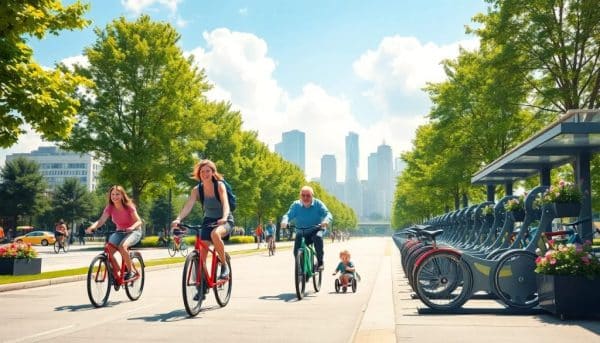Active transportation modes like cycling and walking are crucial for enhancing public health while combating air pollution and climate change. As urban environments grow, these methods provide sustainable alternatives to traditional car travel.
In this article, we will explore how bike hire helps cut down on air pollution and the broader benefits of integrating biking and walking into our daily routines.
How does biking help reduce air pollution?
Biking is one of the most effective ways to reduce air pollution. By replacing short car trips with bike rides, individuals can significantly lower their contribution to carbon emissions.
The impact of bicycle use on carbon emissions is profound. A single bike can replace multiple car trips each week, leading to a notable decrease in pollutants released into the atmosphere.
- Short car trips account for a significant percentage of total emissions.
- Biking produces zero direct emissions, making it a cleaner alternative.
- Increased biking leads to improved air quality in urban areas.
Moreover, cities that promote cycling often experience a reduction in traffic congestion, which further contributes to cleaner air. The more people opt for bikes, the lesser the need for expansive road infrastructure, which can be detrimental to the environment.
How bike hire helps cut down on air pollution?
Bike hire systems are becoming increasingly popular in urban areas, providing an accessible solution for many. By making bicycles readily available, these systems encourage more people to make the switch from cars to bikes.
When considering how bike hire helps cut down on air pollution, it’s essential to note that these systems make cycling easier and more convenient for everyone, including those who may not own a bike. This increased accessibility can lead to:
- Higher cycling rates in cities.
- Reduced traffic congestion.
- Lower overall emissions due to fewer vehicles on the road.
Additionally, bike rental programs often come with infrastructure improvements, such as dedicated bike lanes and parking, which enhance safety and encourage even more users. These factors collectively support a significant reduction in air pollution.
What are the environmental benefits of cycling?
Cycling offers several environmental benefits beyond merely reducing air pollution. When more individuals choose to cycle, there are substantial positive effects on urban ecosystems.
For instance, cycling leads to:
- Decreased noise pollution, contributing to a more peaceful urban experience.
- Lower energy consumption compared to motor vehicles.
- Reduced wear and tear on city streets, saving maintenance costs.
Ultimately, these environmental benefits culminate in healthier communities and ecosystems. By promoting cycling, cities can enhance their sustainability and foster cleaner air.
How does walking help the environment?
Much like cycling, walking is a sustainable form of transportation that can significantly impact air quality. When people choose to walk instead of drive, they contribute to reducing urban air pollution.
The benefits of walking extend beyond just individual health; it also promotes a cleaner environment. Walking does not produce any emissions and encourages urban planning strategies that prioritize green spaces and pedestrian-friendly areas.
Furthermore, when communities embrace walking, they tend to implement more sidewalks, parks, and shared public spaces, enhancing the overall quality of life. This shift towards pedestrian-centric urban design fosters a healthier, more vibrant environment.
How does active transportation combat climate change?
Active transportation, such as cycling and walking, plays a crucial role in combating climate change. By encouraging these modes of transit, cities can significantly reduce their greenhouse gas emissions.
For every mile cycled, there are substantial reductions in carbon emissions compared to driving. This contributes to the global fight against climate change, aligning with international sustainability goals.
Moreover, transitioning to active transportation can lead to the creation of more green spaces, which are beneficial for carbon sequestration. Communities that embrace active transport not only reduce their carbon footprint but also enhance their resilience to climate impacts.
Why is biking better than driving for the environment?
Biking is undeniably a more environmentally friendly option compared to driving, particularly for short trips. Cars emit numerous pollutants that contribute to air quality deterioration, while bicycles do not.
The environmental advantages of biking include:
- Significantly lower carbon emissions.
- Less fuel consumption, conserving natural resources.
- Improved air quality in urban areas.
Furthermore, biking reduces the need for parking spaces, allowing for more green areas and recreational spaces in cities. This shift can contribute to a more aesthetically pleasing urban environment while fostering community engagement.
What role do clean air zones play in promoting cycling?
Clean air zones are specifically designed to improve air quality by limiting vehicular traffic and promoting alternative forms of transport, such as cycling. These zones can significantly impact how communities embrace active transportation.
By creating environments where cycling is safer and more appealing, clean air zones encourage more people to use bikes. This leads to:
- Lower pollution levels.
- Healthier populations.
- Increased investment in cycling infrastructure.
Moreover, clean air zones foster a sense of community, as they often feature pedestrian-friendly spaces and enhanced public transport options, further encouraging cycling and walking.
Questions related to the impact of cycling on air pollution
How does riding a bicycle help reduce air pollution?
Riding a bicycle helps reduce air pollution by eliminating the emissions associated with motor vehicle use. Every bicycle trip taken instead of a car ride decreases the overall amount of harmful pollutants released into the atmosphere.
Additionally, cycling promotes a shift towards more sustainable urban planning, where cities prioritize bike lanes and pedestrian pathways. This environmental shift leads to cleaner air and a healthier ecosystem.
How does biking reduce carbon footprint?
Biking significantly lowers an individual's carbon footprint. Each mile traveled by bicycle emits far fewer greenhouse gases compared to driving a car.
Many studies indicate that replacing car journeys with bike rides can lead to a substantial reduction in overall carbon emissions. This shift not only benefits the environment but also contributes to a more sustainable lifestyle.
How much CO2 is saved by riding a bike?
Riding a bike can save an average of 0.4 kg of CO2 per mile compared to driving a car. Over time, these savings accumulate, resulting in substantial reductions in overall emissions.
For instance, a person who cycles 10 miles a week could save nearly 21 kg of CO2 annually, showcasing the potential impact of biking on air pollution and climate change.
How are bikes better for the environment?
Bikes are better for the environment as they produce zero emissions during operation. Unlike cars, which consume fossil fuels and release pollutants, cycling is a clean alternative that contributes to improved air quality.
Additionally, biking reduces traffic congestion, leading to less idling and fewer emissions from vehicles. By promoting cycling, communities can enhance their sustainability and foster healthier urban environments.


Leave a Reply